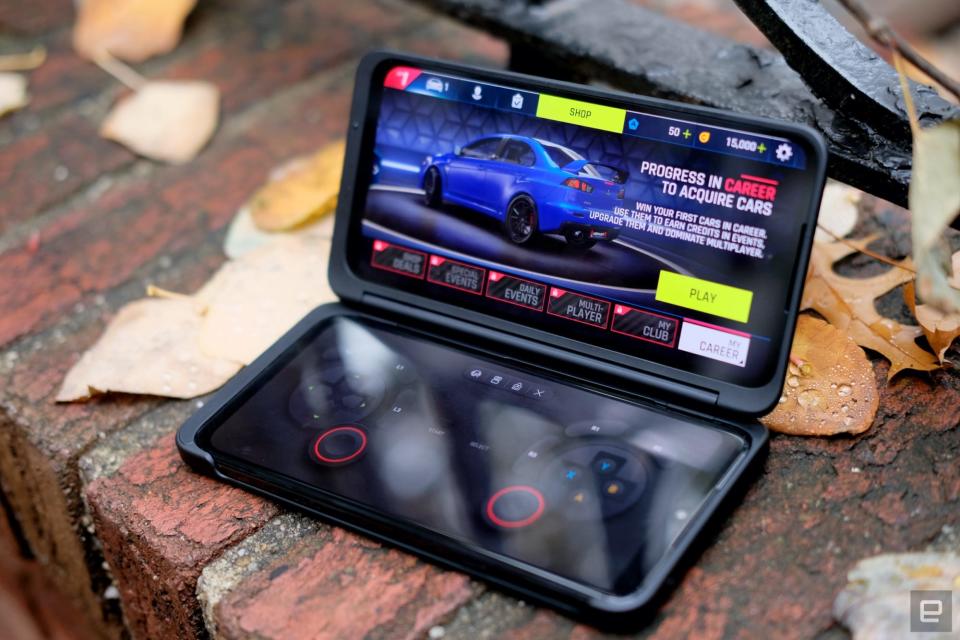LG G8X ThinQ review: More screens aren't always better
It's an oddball phone that might be worth it if you find a good deal.
As far as smartphone makers go, LG is an oddball. It takes a certain degree of chutzpah to design, build and market devices that completely defy convention. And this company has been responsible for more than a few of those over the years. The modular G5 springs to mind. So does this year's G8 ThinQ, which offered a gesture-based control scheme that seemed silly until it didn't. And now there's the G8X, which ditches some of the gimmicks that made the original G8 so divisive and embraces a few of its own.
See, rather than build a proper foldable that would be inherently compromised, LG decided there was a better way to make smartphones more flexible: cases with secondary screens built into them. The V50 ThinQ was the company's first phone to get one of these cases, but now the G8X is going on sale around the world with one of these nutso accessories in tow.
I have a deep, abiding respect for companies willing to embrace weirdness, but I'll be clear up front: LG's vision doesn't work. It's not because the underlying idea is bad; it's because LG hasn't figured out how to use this bizarre, dual-screen setup to its fullest.
The basics
Apart from those dual-screen ambitions, the G8X doesn't stray far from LG's usual flagship formula. Like just about every other high-end smartphone we've seen in 2019, it packs one of Qualcomm's Snapdragon 855 chipset plus 6GB of RAM, so it ran Android 9 (and every app I threw at it) without much fuss. There's a 6.4-inch FullVision OLED screen up front that offers some vivid colors but struggles to amp its brightness enough when being used outdoors. It has a 4,000mAh battery tucked away inside, which was enough to routinely see the G8X through a day and a half of use (with a single screen) before needing a charge. There's a headphone jack here, which -- thanks to the built-in Quad DAC -- helps cement the G8X as one of the best smartphones for people who care about music.
This time, though, LG made a few notable substitutions. Instead of a traditional fingerprint sensor, there's one baked directly into the display that leaves me with few complaints. It's fast enough, and it doesn't struggle to interpret my thumbprint the way some lesser sensors have. More notably, the front-facing Z Camera is gone, so the flaky, sometimes convoluted Air Gestures that debuted on the G8 are nowhere to be found.
Don't worry, you're not missing out on anything, but LG suggests the Z Camera's omission was more a cost-saving measure than a sign of waning confidence in the concept. Instead, we have a more traditional front-facing camera, albeit one that can capture selfies at resolutions as high as 32 megapixels. By default that camera is set to shoot eight-megapixel selfies, but it almost doesn't matter, since the results are barely passable no matter what. Pro tip: When taking selfies, hunt for the best light you can find, because those front-facing photos come out soft and unsatisfying in anything less.
Then there are the main cameras. LG went with two around back: a 12-megapixel standard shooter with an f/1.8 aperture and a 13-megapixel ultra-wide that captures a 136-degree field of view. You'll spend most of your time shooting with the former, and that's a good thing: It captures images with brighter colors and finer detail than the latter does. They're nowhere near Pixel quality, but that's to be expected. LG's cameras have historically been more serviceable than striking. You should also be prepared for some wildly different tones depending on which camera you're currently shooting with. The main sensor does a better job of sucking up ambient light, so it produces decently punchy images. The ultra-wide camera, meanwhile, tends to produce more drab results.
As I mentioned, none of this will sound particularly unusual to people who have used LG phones before. They tend to be perfectly serviceable devices that struggle to stand out against a sea of capable competitors. Perhaps realizing this, LG gave the G8X the greatest gift it possibly could: a more reasonable price tag.
When the G8X goes on sale in the US, it'll set you back about $700 for an unlocked model -- and that includes one of those cases with a screen. LG says the pricing could change after an early promotional period ends, so if you're somehow already fascinated by the G8X, you should probably act fast. After all, $700 is still less than what you'd pay for a brand-new Galaxy S10+, iPhone 11 or Pixel 4, to say nothing of the $2,000-ish Galaxy Fold. Of course, whether that's a good deal or not depends on how well this peculiar dual-screen business works, and I'm not convinced yet.
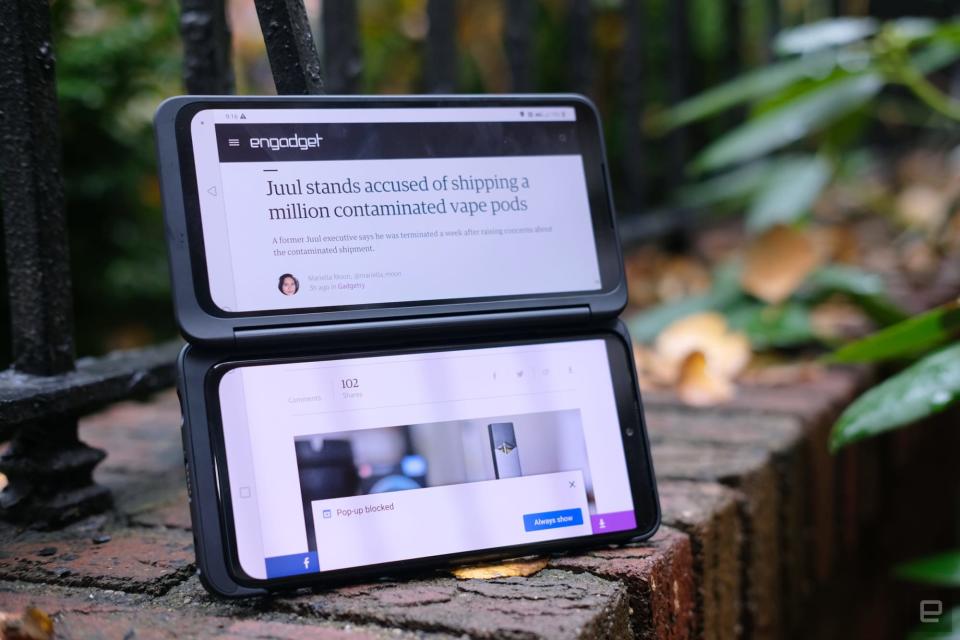
The dual-screen experience
On the surface, LG's approach here is clever. You can add a second screen whenever you need it and leave it at home when you don't. You're never stuck with more phone than you need.
As I said earlier, this isn't the company's first crack at a smartphone case with its own screen. The Korean V50 ThinQ had its own Dual Screen too, and LG clearly learned from some mistakes it made there. Rather than lock into place in three semi-convenient positions, the G8's dual-screen case has enough tension to stay open no matter the angle. This bolt-on second screen is identical to the one built into the phone, right down to the (totally unnecessary) teardrop notch. And there's now a secondary display on the outside of the case so you can see who's calling without having to flip the whole package open.
LG did a much better job building this peculiar case, but actually using it still feels far less than ideal. For one, it basically doubles the size of the phone, and the fact that it doesn't have its own battery means it'll generally drain its host within three to five hours. LG also decided to use a peculiar, seemingly MagSafe-inspired connector instead of a USB-C passthrough on the case, which presents some issues I'll get to a bit later.
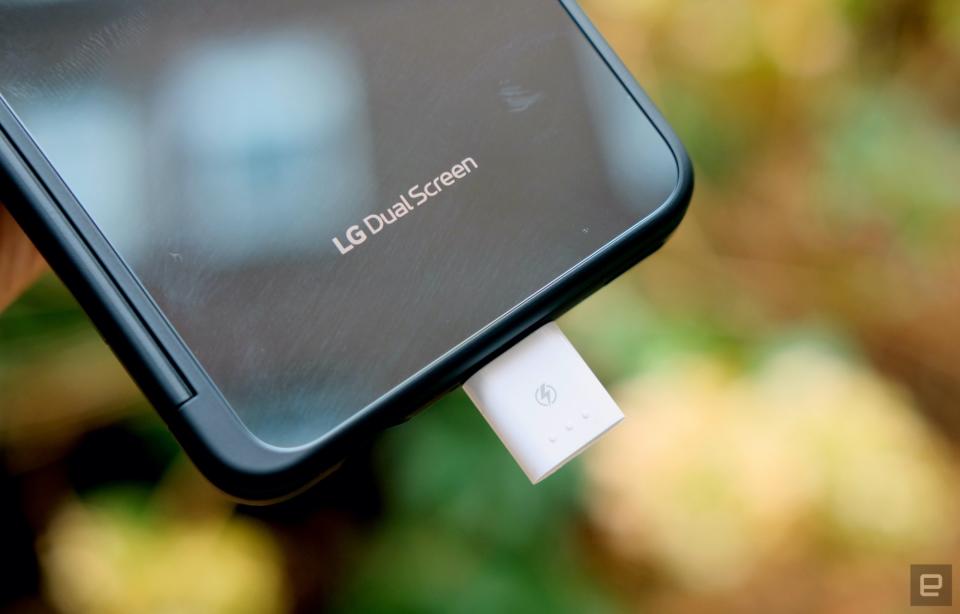
Here's the big picture: LG doesn't love the idea of foldable phones that are basically just tablets that bend in half. Maybe that's why, out of all the apps I've run on the G8X and its little buddy screen, only one -- Chrome -- can be set to run across both displays. In fairness to LG, though, Chrome works well enough when used like this. Problem is, because of the requisite hinge connecting both screens, there's about half an inch of dead space between them. It's unappealing, to say the least.
That's not a problem per se, but it does sort of fly in the face of what I'd want out of a device like this. Part of the appeal of foldables and other multiscreen phones is that I could choose to use all that extra screen space to do the things I want more easily, like reading or watching videos that really shine with more room.
Instead, the G8X and its second screen generally act like two smartphones attached at the proverbial hip. Because both screens are devoted to displaying one app at a time, multitasking can be pretty great here. Over the past week, I've had Gmail parked on one screen while the other played host to either Slack or Google Calendar. And when the workday was finally over, I'd use the two displays to read books in the Kindle app while searching for the right soundtrack in Spotify. Situations like this that benefit from multiple displays aren't hard to come by, but during my time with the G8X, none of them seemed to come up organically. I felt like I had to concoct reasons to run apps on the second screen simply because it was there, not because it made my life any better.
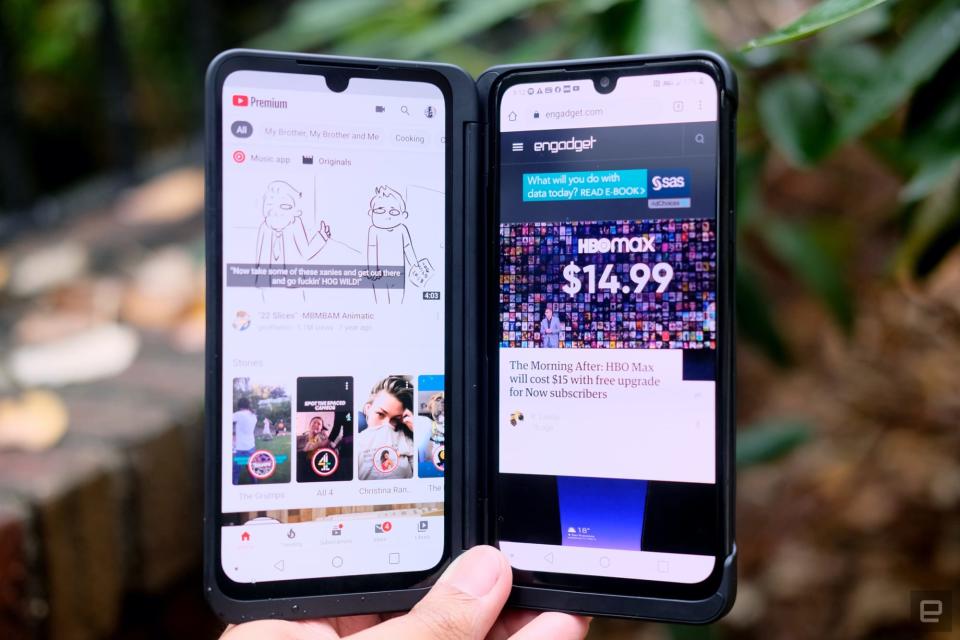
Thankfully, LG cooked up a few ways for both of these screens to work better together. When I used the camera, I could tap the camera roll to view photos I just shot on that secondary display, making it easy to see if I needed to reframe my shot and try again. An LG spokesperson also suggested that because one of the screens could be used to display a full-width keyboard, the G8X could be used "like a laptop." With some effort you can make this work, but at no point did I ever want to place the G8X on a table and type like I would on a computer. Using it like a mid-2000s phone with a discrete keyboard though? Well, that's pretty great, at least when it works.
LG says the G8X is contextually aware enough to know that some apps should automatically use that other screen for typing, and sometimes it is. Other times, apps like the default LG messenger wouldn't display the full-size keyboard on the main screen when I rotated the G8X, even though they should have.
Over the past week, I've found the most pleasure in using the G8X as a portable game console. That's partly thanks to the flagship performance but also because of LG's Game Pad software. Once you fire up a game that supports physical controllers and enable the gamepad, you'll get a full console-style layout on the secondary display that works seamlessly with titles like Asphalt 9 and Modern Warfare 5. The only hitch I've run into is that games that use physical triggers can be tricky, since they require an extra finger on the screen.
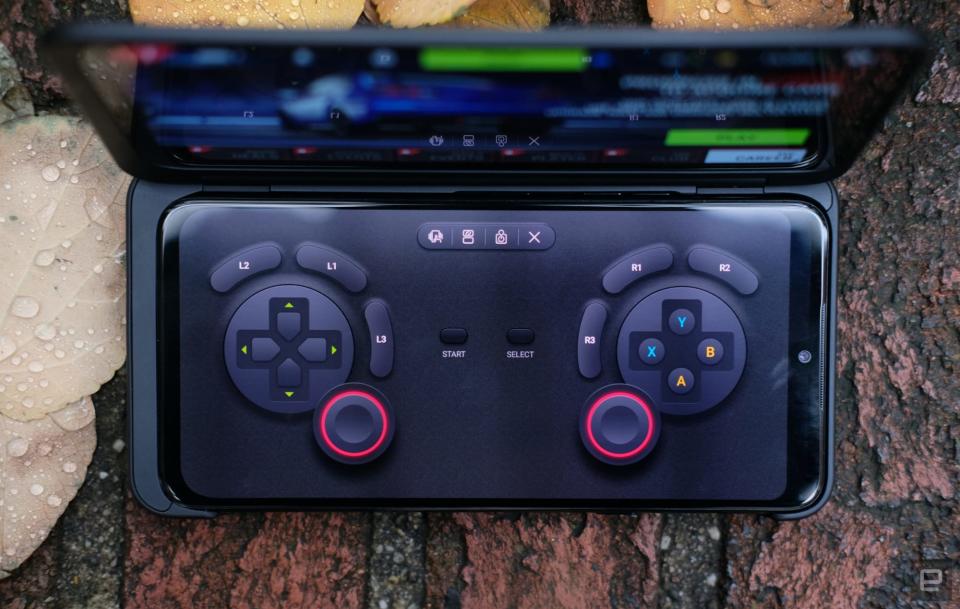
Thankfully, LG's software controller offers a handful of preconfigured layouts for racers and arcade-style fighters to make getting into the thick of things easy. And the best part: You can create custom layouts for games that don't natively support controllers where your on-screen controls simulate taps on the touchscreen. It's not enough to make Call of Duty: Mobile fully playable while Activision sorts out its controller problems, but it did make playing retro games in emulators easier, since I wasn't obscuring the action with my thumbs all the time.
It was mid-game that I finally noticed one of the G8X's most annoying character flaws. After about three hours of plowing through an old-school RPG, the phone started complaining about a low battery, so I set about charging it. In this case, that meant I had to dig out the included MagSafe-like USB-C adapter, attach it to the USB cable and connect the whole thing to the case's magnetic charge pins. As it turns out, it's nearly impossible to avoid nudging the cable and adapter right off the phone, making any kind of dual-screen use while charging basically impossible. I tried flipping the adapter around every which way to double-check that I wasn't making a mistake. But pushing down on the adapter even a little would cause the cable to clatter to the ground. LG's design is just flawed.
That nicely sums up my issue with many of LG's phones. I come in optimistic and intrigued. Too often, though, they're marred by seemingly obvious issues and inconsistencies. I often wonder who at the company saw them and said, "Yeah, that's totally fine."
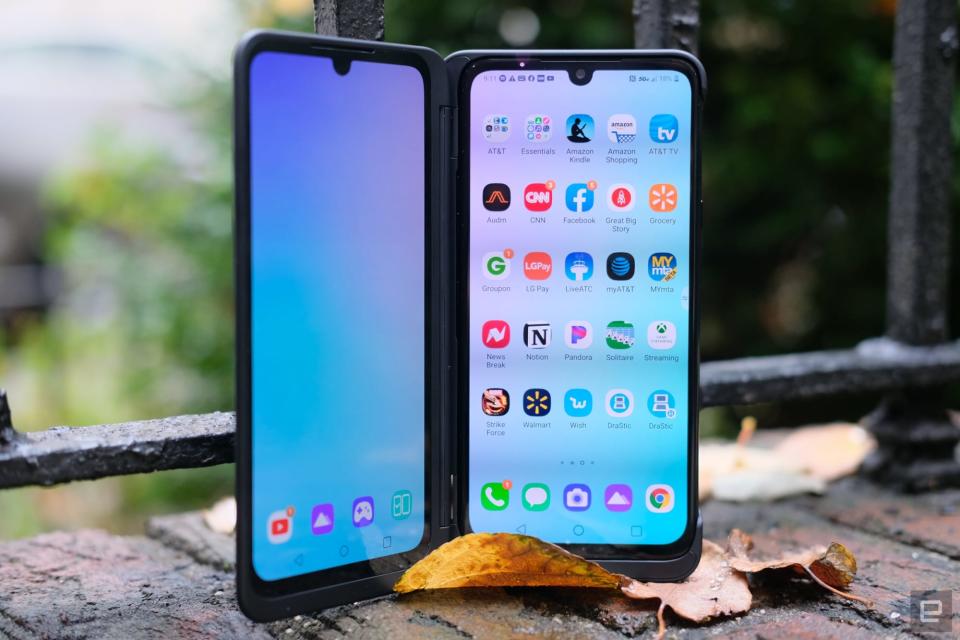
Wrap-up
As a standalone smartphone, the LG G8X is pretty easily outclassed. As a dual-screen device, it shows potential, but the experience is so inconsistent that the G8X never transcends its status as a gimmick. It is, however, a relatively inexpensive gimmick compared to the rest of the year's high-end phones, and that's enough to help me overlook some of the phone's flaws. Assuming you can get a good deal on one, the G8X isn't a bad way to get a feel for the multiscreen life, as unpolished as it is right now. Just don't mistake this phone for anything but what it really is: a stopgap solution while LG figures out what kinds of devices it really wants to make.

